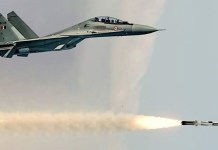India’s Defence Research and Development Organisation (DRDO) has achieved a key milestone in the development of the Air-Independent Propulsion (AIP) system for the Indian Navy’s non-nuclear submarines that allows them to operate without using atmospheric oxygen.
The move is seen as a big boost to the Modi government’s Atmanirbhar Bharat (self-reliant India) initiative.
The DRDO said it has made important progress in the development of the AIP system proving the land-based prototype on March 8, 2021. Developed by Naval Materials Research Laboratory (NMRL) of DRDO with the support of industry partners L&T and Thermax, the AIP has a force multiplier effect on the lethality of a diesel-electric submarine as it enhances the submerged endurance of the boat, several folds, DRDO said.
“While there are different types of AIP systems being pursued internationally, fuel cell-based AIP of NMRL is unique as the hydrogen is generated onboard.” According to DRDO, the system has now reached the stage of maturity for fitment into target vessels.
The AIP module is reported to contain a 270 KW phosphoric acid fuel cell (PAFC), and will be retrofitted on Scorpene submarines of the Indian Navy. using phosphoric acid as an electrolyte that reacts with hydrogen (generated from sodium borohydride) and liquid oxygen to generate electricity. The DRDO fuel cell aims to give endurance of up to 14 days to a conventional submarine.
DRDO achieved an important milestone in the development of AIP System by proving the land based prototype on 8 March 2021. The plant was operated in endurance mode and max power mode as per user requirements. AIP system is being developed by NMRL DRDO. #AatmanirbharBharat pic.twitter.com/Z9ux39XmlT
— DRDO (@DRDO_India) March 9, 2021
The deployment of the AIP system by the Indian submarines is expected to offer a strategic edge to the country over Pakistan, as the system is expected to make the Indian submarines stealthier and harder to detect underwater.
The Pakistan Navy’s 90B Agostas class submarines already have the AIP, although they use the MESMA (Module d’Energie Sous-Marine Autonome) system, which involves burning ethanol with stored oxygen to produce steam which then turns the submarine turbine providing the required propulsion.
The presence of the AIP has been given the Pakistan Navy a significant tactical advantage in its sea denial capability in a regional or bilateral conflict scenario.
With the eventual induction of the 8 Type 093B ‘Yuan Class’ submarines from China, Pakistan Navy is making huge strides in bolstering its sea power. The Type 093B, however, come with a Stirling generator AIP, which uses a closed-cycle diesel engine.

The development of the indigenous fuel-cell AIP technology moves India closer to becoming a self-sufficient nation in building its own submarines. The system is expected to arm the next generation of conventional submarines of the Indian Navy, under the Project 75I class.
According to the military experts, Pakistan will now need to be extra-vigilant in light of the newly acquired capability of India and extend its surveillance over a wide area. Pakistan is also due to induct the new Type 093B Chinese subs, expected to be acquired in 2023, and India’s AIP acquisition balances that capability through operational effectiveness.
The single greatest limitation of the Indian submarines has been their inability to remain underwater for a significant amount of time to preserve their stealth and avoid being exposed.
The conventional submarines have this vulnerability where they need to rise to the surface to recharge their batteries, and with their limited endurance, they get exposed to air and surface detection by the adversary.
The underwater duration of a submarine depends on many factors, including the speed, propulsion, the equipment running on board, and the tactical situation prevalent in the area.
The conventional submarines are propelled by electric motors, which in turn are powered by batteries charged through diesel generators. However, the requirement for the diesel generators to run on air means the submarine will run out of it frequently and will have to rise to the surface to get the air supply again.
Typically, it’s usually about every 2-3 days for the Indian submarines when they need to rise to the surface. This problem is solved by deploying the AIP system, which allows the whole propulsion system to run without having the need for external air.
Comparatively, nuclear submarines have far longer endurance and can remain submerged for months on. Some countries such as Japan are already moving away from even the AIP system to lithium-ion batteries, while the US only uses nuclear-powered submarines.
India is due to commission its third Scorpene class submarine on March 10, while two vessels have already been commissioned. Six French-origin Scorpene-class subs are expected to be commissioned into the Indian Navy, which in addition has 12 other diesel-electric submarines which are aging fast and need replacement.
Follow EurAsian Times on Google News




